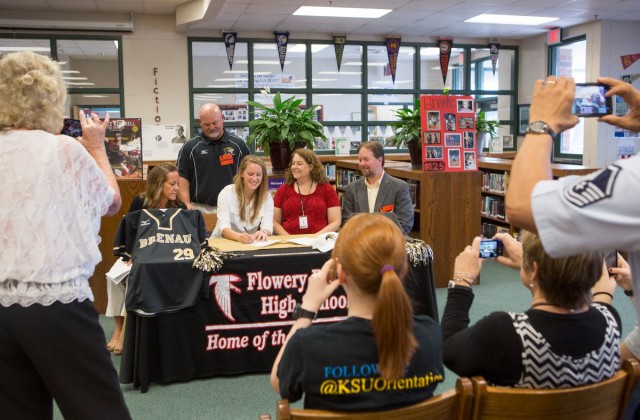Now Playing!
When a promising Golden Tigers basketball season ended early because of injuries to key players, it would have been nice to have a spare tank stocked with athletes who could step in. With addition of developmental teams in basketball and softball – along with expansion of the cheer program with a third unit – Women’s College intercollegiate sports begin to play nicer.
Brenau University revived a concept from the past to prepare for the future in adding new teams to its intercollegiate athletics roster this year.
The Golden Tigers have added junior varsity teams in basketball and softball as well as a third component, dance, to the competitive cheerleading team. The new programs opened spaces for about 40 more student athletes on campus, bringing the total number of Women’s College students participating in intercollegiate athletics to about 180 – slightly less than a fourth of the entire WC student body.
“It’s a natural progression,” Athletics Director Mike Lochstampfor said. “In basketball it was the model we had in mind when we started the program in 2006, but then the budgeting and planning process didn’t go where we thought it might.”
Now it has. Lochstampfor’s proposals for the additional costs – scholarships, recruiting, travel, equipment and such – were approved in 2014, and by the beginning of 2015, recruiting was under way.
The use of junior varsity teams was widespread on many levels of college sports, and it was a common practice before the NCAA changed its rules to allow freshman eligibility in 1972. However, Title IX, which prohibits gender discrimination in federally funded education programs, including sports, was enacted that same year, but did not immediate affect sports for women. The NCAA still did not sanction them. It did not have much effect in the NAIA, either, said Lynn W. Meredith, the vice president for marketing and communications for the NAIA.
The NAIA preceded the NCAA by offering title play for women beginning in 1980, and looking back through the record books, Meredith said, freshmen were playing in the late 1950s and possibly earlier. “I have no reason to believe that we ever had a policy under which freshmen were ineligible,” Meredith said.
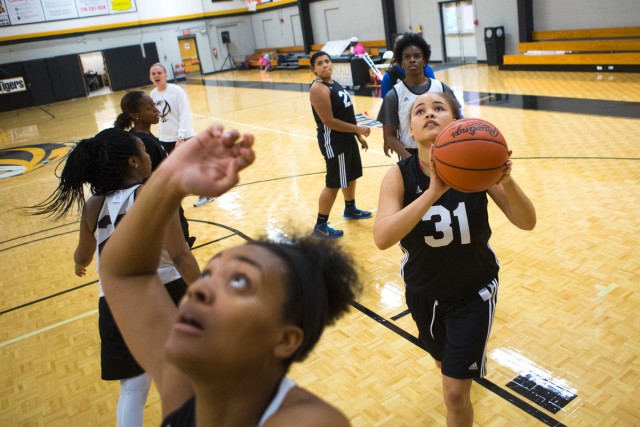
Leading the Pack
Brenau leads the current trend of re-establishing junior varsity sports, but it isn’t alone. Meredith said an NAIA-wide study (men and women) shows that in 2013–14, 134 NAIA schools sponsored at least one JV program.
Southern States Athletic Conference Commissioner Mike Hall estimates that “about half” of the league’s 14 schools have at least one or two junior varsity programs.
“There are probably several in soccer, several in basketball, baseball and softball. Those are the ones that jump out to me the quickest,” he said. He also said that the conference does not have plans for junior varsity championships.
“It’s a development type of approach for schools,” he said, “a chance for players to develop and move up to varsity. And for athletes, it’s a chance to continue what you began in high school, to play against outside competition, and it’s good to stay active in that. If you’ve been doing something your whole life, you want to continue doing it. You don’t want it to end.”
Lochstampfor said he likes to think of the additions as “secondary” teams instead of junior varsity, because there will be movement between the teams, and because all of the athletes will be representatives of the university.
The program, he adds, makes Brenau athletes more visible in the community, and helps the university retain students who might go elsewhere if they had no opportunity to play sports. “Sometimes they need more development before they’re ready for varsity play,” he says. “Sometimes they’re coming off an injury. This gives them reaofexperience that they wouldn’t get just by practicing. Players play hard in practice, but they play harder in games. That’s just typical of the people we are. Playing in front of people requires a different level of maturity, and this will help make their transition smoother.”
Lochstampfor and basketball coach Kris Stewart both cite this season as one in which a junior varsity team would have provided welcome help. Stewart’s already young team was hit hard by injuries – including season-ending injuries to guards Quinnesha Turner (torn ACL) and Dominique Patrick (dislocated ankle) – and finished the season 6-12 in SSAC play, and 11-16 overall.
Stuff Happens
This season there would have been plenty of opportunities for a junior varsity player to move up, Stewart said, since by early December “eight of our 16 players had some kind of physical issue that was either limiting them or holding them out” of the lineup. “It would have been awfully handy to have had the JV team then,” he said, “just to use some of the players in [varsity] practice, and for depth in games.”
With his entire team returning – this past season’s roster had one freshman, nine sophomores and six juniors – Stewart’s recruiting priority now is for the junior varsity.
“I’m being honest with them, because pretty much everybody thinks they’re a varsity player from day one,” he said. “So I’m saying, ‘Why not give junior varsity a shot? You might not be ready now, but there’s a possibility that in a year or two you will.’”
He’s also looking for hidden gems – recruits who might have been overlooked, “from rural schools or small private schools, or those who may not have played AAU ball.”
The positives, he said, for some of the players who end up on the junior varsity is that they still have a chance to continue their basketball careers, and can pursue them, as well as their academic and social adjustments to college, “at a slower rate.”
“They’ll be learning basically the same system with less of a time commitment, and they’ll have the time to progress and learn without the pressure of competing against physically more mature players,” he said.
The NAIA maximum for varsity games is 30, not counting postseason and exhibitions, and Stewart anticipates a schedule of about 12–14 junior varsity games initially.
Coach Development, Too
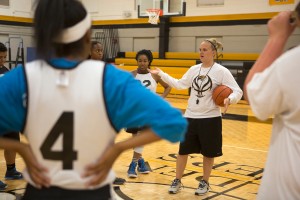
Graduate assistant Kayla Aiken will be the official junior varsity head coach, but Stewart expects to spend quite a bit of time helping and guiding as the new team gets started.
“It’s a great opportunity for her to get head coaching experience,” he said, “but until we get all of the logistics worked out, I’ll be helping as much as I can. I also think it’s important that those (junior varsity) players continue to have some interaction with me.”
Lochstampfor said he always considered the addition of junior varsity teams to also be a coaching development tool, something he learned from personal experience when he worked as both an assistant and a head junior varsity coach while working on his master’s degree.
“It gave me a lot of valuable experience,” he said. “As an assistant, there’s always someone to fall back on, but when you’re the head coach, things are just a little bit different.”
Softball coach Devon Thomas is also recruiting specifically for the junior varsity team, careful not to promise a spot on his varsity, which after a 1-19 start-up season in 2003–04 has grown into a national power.
The Golden Tigers have consistently been ranked in the top 25 nationally since 2009, and made their first Final Four in 2012.
“That first year was terrible,” said Thomas. “I was literally looking for athletes in the lunch room. I’d see a girl eating with both hands, and think, ‘Hey, she’s ambidextrous, maybe she can play.’ But they trusted me here and gave me time to build, and we’ve grown up. Now I get maybe 25 emails a week asking about playing here.”
That’s why he’s taking care in his approach to junior varsity recruiting.
Solid Athletes
“We’re going to be looking at solid athletes, maybe those who have been overlooked, or have a certain skill they need to develop. My thinking is that it’s a development team, like Class AAA,” he said.
Like Stewart, Thomas will divide the coaching duties, designating his longtime assistant, Gary Hatfield, as the head junior varsity coach. Hatfield still will continue his duties as assistant with the varsity and overall strength coach. Thomas hopes to add another assistant, perhaps a graduate assistant, to lighten their load.
Like the basketball JV team, the softball team will also play a shorter season than the varsity. The varsity averages 50 to 60 games over 28 play dates. Thomas expects the JV to have a roster of about 10 athletes, and to play about 20 games over 10 play dates.
Like Stewart, he doesn’t expect a great deal of movement between the squads, but envisions times when the extra bodies will come in handy.
“We play a top 25 schedule,” he said, “and if someone has been hurt, they may need some extra rehabilitation time. You don’t always want to throw them right back in there.”
SSAC commissioner Hall said he thinks one factor driving NAIA schools toward adding junior varsity teams is that it is a tool to boost enrollment. “They [schools] may be adding or considering junior varsity sports in areas where they are strong, and where they have the facilities,” he said, “and for the good recruiting base it makes. For each school, it’s just a matter of philosophy, of what the president expects.”
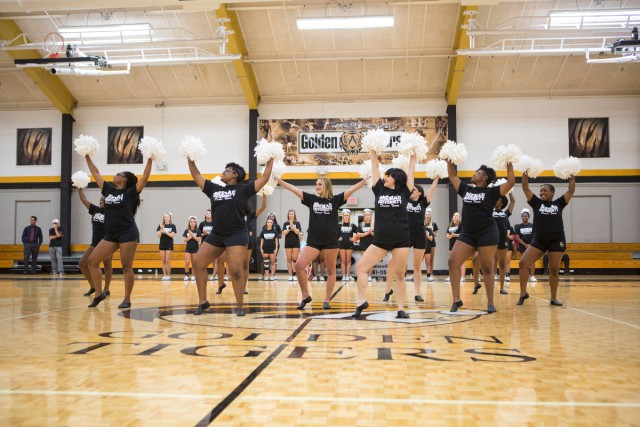
The NAIA’s Meredith said junior varsity programs can also aid in student retention. A player who wants to compete, but can’t land a spot – or playing time – on the varsity might choose to transfer. But given a JV option, that player often might choose to stay.
“The continuous relationship with the same institution and coaching staff can also enhance the mentor relationship between the student and coach, and is in the best interest of the student academically,” Meredith said.
In addition to junior varsity being a concept whose time has come — or come back — there were other factors in Brenau’s why-now equation.
One is facilities. The development of a multipurpose athletic park that will give the Brenau softball team its own home field was a game changer, Lochstampfor said. “We leased our space prior to that, and expansion wasn’t really an option when we were leasing from the city of Gainesville,” he said. Thomas was hoping he’d be playing on the new field this year, but now is using next year’s opening of the field and new locker room facilities as a recruiting tool.
The other is geography. Travel costs will increase, and logistics will get a bit trickier, but Brenau is fortunate, Lochstampfor said, because “there are quite a few comparable programs and a few junior colleges within two or three hours of us, and between the two, we’ll be able to fill the schedules without much difficulty. We’ve researched this the last few years, looking at what other schools have done, and what the positive impacts and potential challenges are. Administratively, you’ve got more travel, more events to juggle, but in our case, the infrastructure is pretty much already in place.”
Stewart said his initial reaction was to mentally begin tallying the positives and negatives about the change.
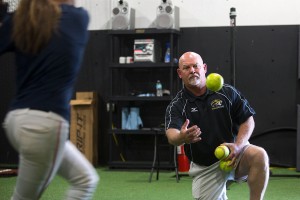
“The list of negatives is pretty short,” he said. “I’m not sure the right word is negatives. It’s more of a challenge to figure out what you’re going to do and how you’re going to do it. The challenges would be logistics, equipment, timing, things like that, and making sure you’ve still got time to deal with each athlete’s individual needs.”
And, he said, he’s already received an unexpected benefit.
“Sometimes,” he said, “when you start thinking over the challenge of how you’re going to do something new, you look at what you’ve already been doing, and you realize that there are some of those things that you could have been doing better. And that’s a good thing.”
Eye Toward the Future
For cheerleading coach Krista Britt, the addition of a dance squad is just one more opportunity to build on success. In its first three years of existence, the Brenau team finished in the top four at the National Cheerleaders Association college nationals tournament.
But the team was formed in 2011 with an eye on the future, because the NAIA had designated it an “emerging sport,” with plans to add a national championship as soon as enough schools participated. That goal has been reached, though Brenau is the lone participant from the Southern States Athletic Conference.
“I’m excited,” said Britt. “One of the major reasons I took the job at Brenau was because of the coming recognition of it as a sport.”
Competitive Cheer & Dance becomes a title sport in 2016, but Britt says, the new dance component will be separated in competition, with separate titles.
“One does not help out the other. The evaluation and scoring systems are drastically different,” she said.
Britt said she expects to add “12 to 14” recruits for the dance squad. She doesn’t plan to name a separate head coach, but will oversee all three facets of her program : spirit, cheerleading and dance.
Karen Allen is a freelance writer living in Fort Collins, Colorado.
